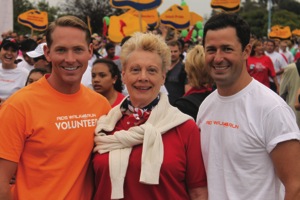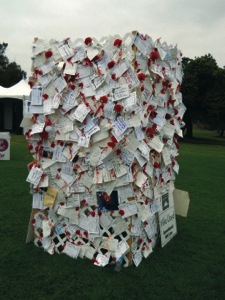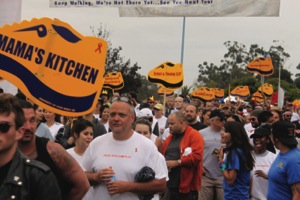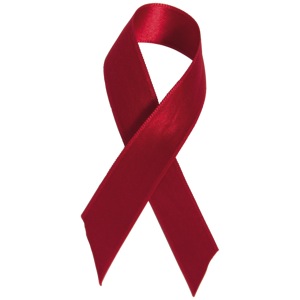
This year the AIDS Walk launched a Facebook site for participants to answer the question, “Who are you walking for?” Some weeks ago this writer attended a team leader informational meeting. At the end of the session the leader asked the attendees to answer the question on video. That gave me pause to think back 27 years ago as to what my motivation was as founder of the Walk to undertake such a huge task for a cause whose name, AIDS, struck fear and bigotry in the hearts of most of the public. The question brought back memories of 1985; people were dying daily from the dreaded “gay plague” and fear was palpable in the streets of Hillcrest and in the halls of USCD Hospital’s Owen Clinic. In 1985, the consequences for a roommate of being seen in the waiting room at Owen Clinic could often have been to come home to find their clothes and personal items in the street and locks on the doors of their apartment.
The LGBT community needed a vehicle from which to raise public awareness, dispel the fear and myths about the disease and engage the general public in gaining support for education, compassion, medical services and money for people infected with and affected by the HIV virus. The AIDS Walks in New York City, Los Angeles and other large cities had accomplished those goals and the same thing was needed in San Diego. The Walk was named “San Diego Walks for Life” because at the time, in 1985, no one would write a check or put their name on a poster that said “AIDS”. Walking for Life, while maybe not so politically correct to some, gave participants, and sponsors in 1985 a way to sponsor an “AIDS” Walk. The answer to the question, “Who are you walking for?” in 1985 was the 265 personal friends lost and for the hope and ability to raise hope for those who were currently living with the virus and the stigma that went with the virus. While there was a feeling of victory in seeing the first walk actually take place, and there were balloons and some celebratory stage decorations, the 1,500 participants who marched from the County Administration Building and around Harbor Island and back were much more like silent protestors at a vigil, or participants in a funeral march. Participants and founder were walking for the memory of those lost, and hope and celebration for the living.
This year is the 27th anniversary of AIDS Walk San Diego and there certainly is cause for celebration about being alive and healthy while HIV+. Times have changed and progress has been made, but the question “Who are you walking for?” should prompt us to think about the most current CDC statistics and who are those human beings that are represented by new infection statistics? We should remember and acknowledge that HIV is no longer a “gay disease” and it is no respecter of persons or color. Over the past 27 years, deaths and rates of infections have substantially decreased and many HIV+ individuals are living healthy and manageable lives. However, there is great danger in holding an attitude of indifference to the serious nature of becoming HIV positive. HIV is still a killer virus, and to think otherwise is foolish. There is no cure.

While gay white men are still the largest portion of those new cases, there is a disproportionate amount of HIV in the African American and Latino communities and a disproportionate number of women of color becoming high on the statistical chart at an alarming rate. Women get sicker faster and die sooner, as did gay men in the ‘80s and for very similar reasons. Cultural stigmas, bigotry, poverty and indifference to “those who brought it on themselves” are all contributing factors.

In 2009, black men accounted for 70 percent of the estimated new HIV infections among all blacks. In 2009, the rate of new HIV infections among black women was 15 times that of white women, and more than three times the rate among Hispanic/Latina women. Women accounted for more than 25 percent of the AIDS diagnoses and represent nearly 20 percent of cumulative AIDS diagnoses in the United States to date. The most common method of transmission is heterosexual contact. The HIV virus is everyone’s virus and the statistics should give us all pause to think about “Who are you walking for?” in 2012.

On the AIDS Walk San Diego Web site this year is a compelling story of Maria. As a way to share the joy Maria brought to her friends, several of them formed a team for this year’s walk called the Butterfly Bandits. They are walking as a means to honor and celebrate her life and share the grief of her loss. They related on the Web site article that they “were surprised to find out how quickly Maria’s health declined and we were shocked when we found out that we had lost her.” Her sister had shared that she was having trouble with her medications and she just wasn’t finding the help that she needed from her doctors. There was a time when she lost her health insurance because she lost her job and lost access to her medication, which contributed to the progression of her illness. When Maria first learned that she was HIV+ she shared with a few friends. Not long after her diagnosis she moved back to Arizona to be closer to her family. Maria passed away Sept. 20, 2011 in Goodyear, Ariz. She was 33 years old.

We may have cause to celebrate “being alive and HIV+” in the LGBT community but there is still a war being waged by the virus on those who do not have the financial resources to fight it, and whose cultural stigmas can quickly make a sick person a sick homeless person even in 2012. AIDS Walk San Diego 2012 should be a day of reflection to honor those passed, a day of hope for the HIV community living healthy lives. AIDS Walk San Diego 2012 is a day to celebrate the lives of the living, but it is not a day to celebrate victory over HIV until they find a cure. Who are you walking for?











